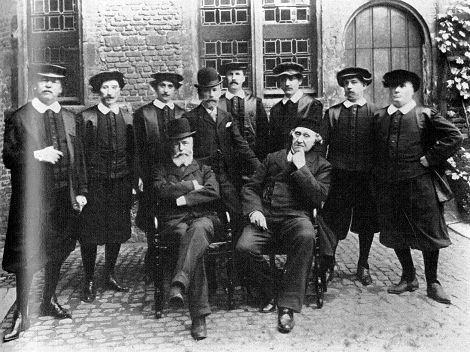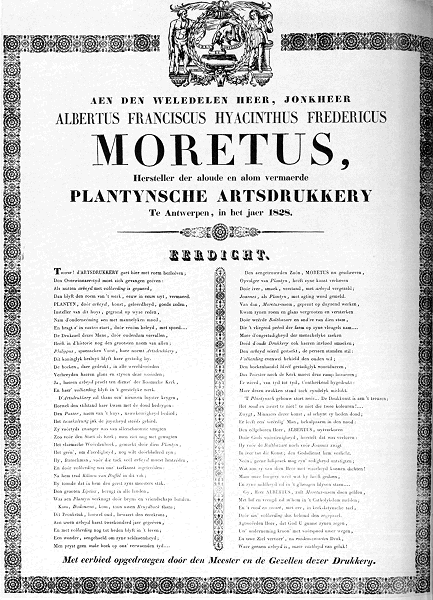The Golden Compasses
(1969-1972)–Leon Voet–The History of the House of Plantin-Moretus
[pagina 407]
| |
Chapter 14
| |
[pagina 408]
| |
other estimates were too high. Edward Moretus was angered by the insulting tone of the ministerial letters and refused to reconsider his price. The Antwerp authorities, convinced of his reasonableness, did not even make him any new offers. The transaction seemed on the point of falling through when the Count of Flanders managed, at the last moment, to persuade the minister to change his attitude, or at least to modify it: the government would contribute 200,000 francs; Antwerp would have to find the remaining million. This the city did and it was able to arrange credit terms with Jonker Moretus. On 10th August 1875 the city council voted unanimously in favour of the purchase, expressed its appreciation of the Count's efforts and praised the Jonker's love for his native town. On 20th April 1876 the deed transferring the Plantin house to the City of Antwerp was signed. The necessary adaptations and restorations were quickly carried out, so that by 19th August 1877 the Gulden Passer could be opened to the public as the Plantin-Moretus Museum.Ga naar voetnoot1. Emmanuel Rosseels, an Antwerp literary figure, was made technical director (until his retirement in 1902); Max Rooses was made curator. He held this office until a few months before his death on 15th July 1914. After 1902 he added Rosseels's former duties to his own.Ga naar voetnoot2. Max Rooses was a native of Antwerp. He was 37 when he left the Ghent athenaeum (a state grammar school) in 1876, where he had taught Dutch language and literature, and returned to his home town as curator of the new museum. He had already made a name for himself as a literary critic, and as an ardent, liberal Fleming, militant in the cause of his people and their language. He continued these activities, playing quite an important part in the political life of the city. But even before he returned to Antwerp he had felt himself drawn towards history and the history of art. With an amazing | |
[pagina 409]
| |
energy and capacity for work, and with an erudition and breadth of intellect which made him Belgium's first great art historian, he launched himself upon the twofold task of illumining the lives of the masters of the Golden Compasses and studying the seventeenth-century painters of the Antwerp School. He achieved prodigious feats, publishing not only an impressive number of detailed studies and editions of source material, but also standard works on Christophe Plantin, Rubens, Jacob Jordaens and Van Dyck - and although whole libraries of books have since been written on these great figures from the artistic and cultural history of the Southern Netherlands, these works have not been superseded after all these years and still need to be consulted. Under Max Rooses's leadership, the old Plantin house became not only a world-renowned museum but, as in the days of Plantin and Balthasar I Moretus, an active centre of scholarly research.Ga naar voetnoot1. Rooses also attended to the extension of the collections. The particular character of the Plantinian house meant that only some of these were suitable for enlargement. Furniture, paintings and other art objects, manuscripts and typographical material had all to be regarded as integral parts of the former printing-press and family residence; as such these collections were virtually complete in themselves and it was not possible, or desirable, to add much to them. The library, however, was capable of enlargement and here Rooses established straight away the guide-lines of a policy which the Museum authorities have consistently followed ever since: the acquisition of missing Plantin and Moretus editions, and the extension of the collection of old (i.e. pre-1800) Antwerp impressions. One of the later Moretuses was a devoted collector of graphic arts and his folios of prints were also acquired by the city at the transfer of 1876. Rooses, with his intense interest in art history, made this small section his special care and began his unremitting efforts to enlarge it. At the same time he thought that the City of Antwerp was under a moral obligation to buy drawings and prints by living Antwerp artists. He managed to obtain permission from the city fathers to make purchases and - more important - also suc- | |
[pagina 410]
| |
ceeded in extracting credit and subsidies from them and from other authorities and private donators. Together with the librarian F. Gittens he was able to bring about the establishment in 1905 of the ‘Bestendig Dotatiefonds voor Stadsbibliothcek en Museum Plantin-Moretus’ [Permanent Donation Fund for the Antwerp Municipal Library and the Plantin-Moretus Museum] which has contributed so much to the enrichment of the two institutions.Ga naar voetnoot1. The collection of drawings and prints by Antwerp masters, old and new, became so large in course of time that it outgrew the Museum and had to be transferred to a separate building in 1936: the ‘Stedelijk Prentenkabinet’ (Municipal Gallery of Prints), specially set up for this purpose in a house at the corner of the Vrijdagmarkt, next door to the Museum.Ga naar voetnoot2. Max Rooses retired in 1914, a few months before his death. His deputy, Dr. Jan Denucé, succeeded him. Dr. Maurice Sabbe took over from Dr. Denucé after the 1914-18 war. Sabbe was a well-known Flemish literary figure who, like Rooses, had previously taught Dutch language and literature at a secondary school. He proved a sound historian and published many notable articles and books on Christophe Plantin - and particularly on the Moretuses, who had been rather neglected by his predecessor.Ga naar voetnoot3. It was during Sabbe's curatorship that the independant Prentenkabinet mentioned above was established, with A.J.J. Delen as its first curator,Ga naar voetnoot4. followed in 1945 by Frank van den Wijngaert.Ga naar voetnoot5. Maurice Sabbe died on | |
[pagina 411]
| |
12th February 1938 and was succeeded by the assistant curator, Dr. Herman Bouchery.Ga naar voetnoot1. The Second World War broke out. Air raids on occupied Belgium by the Allies took place and in 1942 the Plantin-Moretus treasures, with collections from other museums, were taken to the castle of Lavaux-Sainte Anne near Namur. When the Allies landed in Normandy the evacuation of the castle was ordered. In the midst of all the chaos the art treasures were transported back to their respective towns but on 26th August 1944, near the bridge at Dinant, the column of vehicles was mistaken by Allied aircraft for a German troop convoy. Five people were killed and serious damage was done, but the Plantin-Moretus collections got off relatively lightly. Only a few books and the fine eighteenth-century clavicymbal were struck by bullets; the latter was damaged badly but not beyond repair.Ga naar voetnoot2. The worst, however, was yet to come. German flying bombs began to fall on Antwerp. The Museum treasures, dispersed at various storage places, survived the rest of the war unscathed, but not the Plantin house itself. On 2nd January 1945, at 10 o'clock at night, a V2 rocket hit the Vrijdagmarkt, causing great destruction over a wide area. Although only some 50 yards from the point of impact, the Museum remained standing. It suffered extensive damage, however, and in the bleak winter weather it had the forlorn look of all bombed buildings: windows shattered, beams and woodwork splintered and twisted, roofs and walls gashed. The front wall of the building was left practically intact as the wide windows there let the blast waves straight through. There was no such easy outlet at the back of the house and the blast wrenched the gable facing the courtyard out of its joints, leaving it leaning at an angle.Ga naar voetnoot3. | |
[pagina 412]
| |
Under the direction of Dr. Herman Bouchery (appointed professor at Ghent University in 1946) and Frank van den Wijngaert (responsible for the running of the Plantin-Moretus Museum from 1946 until 1950), two men who had given sterling and untiring service all through the war and who now spared themselves just as little, the first repair works were begun. The actual rebuilding could not be started until 1947. This extremely delicate task was carried out with great care and precision by the appropriate city departments, under the leadership first of the architect A. de Mol, then of the chief architect A. Fivez and his assistant R. van Noten.Ga naar voetnoot1. On 38th July 1951 the Plantin-Moretus Museum could at last be opened to the public again. | |
[pagina *105]
| |
 (104) The staff of the Plantin-Moretus Museum in 1902. The seated figures are Max Rooses (left) and Emmanuel Rosseels (right). Standing behind them is the assistant keeper G. Gilbert. The other men are doorkeepers and supervisors; their livery was inspired by sixteenth-century costume.
| |
[pagina *106]
| |
 (105) Poem addressed to Albertus F.H.F. Moretus by his foreman and journeymen, printed in 1828 (cf. p. 253).
|
|

